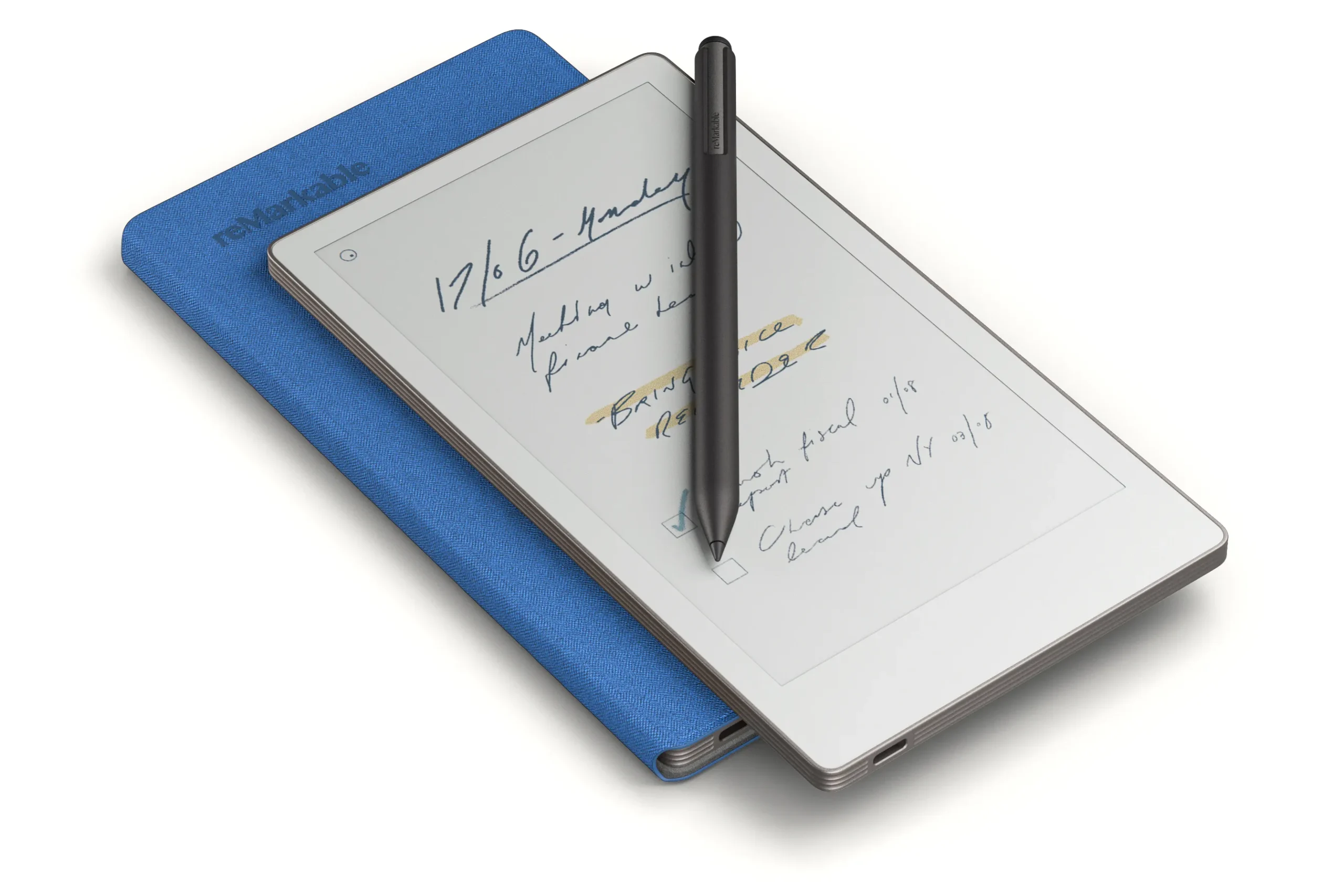In an era where digital productivity tools are evolving rapidly, the E Ink tablet stands out as a bridge between traditional note-taking and cutting-edge technology. These devices are characterized by their paper-like displays, which reduce eye strain, and extended battery life that lasts for days and possibly even weeks. And the good thing here is that they are now incorporating artificial intelligence (AI) to revolutionize how we handle handwritten notes.
Imagine jotting down ideas during a meeting, only to have an AI smart assistant instantly convert them into searchable text, summarize key points, and even integrate them with your digital ecosystem. As of 2025, this isn’t science fiction—it’s the reality for users of advanced E ink tablets like the Remarkable Paper Pro and Onyx Boox series. This article explores how AI integration is transforming handwritten notes, making E Ink tablets indispensable for professionals, students, and creatives alike.
Recent trends such as hybrid work and remote learning have translated into a rise in demand for distraction-free devices. E ink tablets offer a minimalist alternative to traditional tablets, focusing on reading, writing, and organization without the constant notifications of an iPad or Android devices. By embedding AI, manufacturers are enhancing these tools to not only mimic paper but also augment human cognition. According to recent industry insights, AI-powered features in E Ink tablets are driving adoption, with handwriting recognition becoming a standard capability. This integration promises to make note-taking more efficient, accessible, and intelligent, turning scribbles into actionable insights.
What Are E Ink Tablets?
E Ink tablets are specialized devices that use electronic ink or E Ink technology to create displays resembling printed paper. Unlike LCD or OLED screens, E ink screens reflect ambient light, making them readable in direct sunlight and easier on the eyes for prolonged use. Popular models include the Remarkable 2, Supernote Nomad, and Onyx Boox Tab Ultra C Pro, which prioritize low power consumption—often lasting up to two weeks on a single charge.
At their core, E Ink tablets are designed for note-taking, reading, and annotating documents. They come with styluses that provide a natural writing feel, complete with pressure sensitivity and minimal latency. For instance, the Remarkable Paper Pro features an 11.8-inch color display with adjustable lighting, allowing users to jot down notes or mark up PDFs seamlessly. What sets modern E Ink tablets apart is their shift from simple digital notebooks to intelligent companions, thanks to AI. These devices now support features like real-time handwriting-to-text conversion, which uses optical character recognition (OCR) powered by AI to digitize notes instantly.
The appeal of E Ink tablets lies in their focus on productivity without distractions. Unlike full-fledged tablets, they often lack app stores or web browsers (though some, like Onyx Boox, run Android and offer Play Store support for more versatility). This minimalist approach, combined with AI, makes them ideal for transforming handwritten notes into organized, searchable digital assets.
The Evolution of AI in E Ink Tablets
The integration of AI into E Ink tablets has accelerated in recent years, driven by advancements in machine learning and natural language processing. Early E ink devices, like the original Remarkable, focused on basic digitization, but 2025 models incorporate sophisticated AI assistants that go beyond mere transcription.
For example, the iFLYTEK AINOTE Air 2 leverages AI for voice-to-text and handwriting recognition in multiple languages, turning an E ink tablet into a multilingual productivity hub. Similarly, Onyx Boox devices feature native OCR that converts handwriting to text in real-time, enabling users to search notes or integrate them with apps like Google Drive. Industry observers speculate that in the future, advanced AI assistants, including those developed by companies like OpenAI, could power dedicated E Ink tablets, with semantic search and persistent memory.
Social media discussions highlight this shift, with users envisioning AI-driven E ink tablets that handle conversations, meeting notes, and summaries in one place. Tools like Smart Script and MyScript Nebo demonstrate how AI can fluidly convert handwritten notes into editable text, enhancing organization on mobile devices. As AI models improve, E Ink tablets are becoming proactive—suggesting summaries or linking notes to calendars—transforming passive handwriting into dynamic knowledge management.
Key AI Features Transforming Handwritten Notes
AI integration in E Ink tablets is reshaping handwritten notes by adding layers of intelligence. Here are the standout features:
Handwriting Recognition and Conversion
One of the most transformative AI features is advanced handwriting recognition. Devices like the Supernote Manta use AI to analyse handwriting, converting it into typed text while preserving the original strokes. This allows users to edit notes digitally without losing the tactile feel of writing. The Remarkable Paper Pro excels here, with handwriting-to-text conversion that integrates seamlessly with Slack or email.
Some AI note-taking platforms now support dozens of languages (iFLYTEK claims over 80), making E Ink tablets increasingly accessible worldwide. For instance, Google AI’s models can digitize handwriting strokes without specialized equipment, outputting realistic digital text. This feature is invaluable for students or professionals who need to search through volumes of notes quickly.
Smart Summarization and Organization
AI smart assistants now summarize handwritten notes automatically. Tools like HyNote AI turn photos, audio, and notes into structured documents. On E Ink tablets, this means AI can distill meeting notes into key action items, organizing them into notebooks or folders.
The Viwoods AI Paper, for example, links notebooks to calendars and uses AI for handwriting analysis, predicting user needs. This level of organization reduces cognitive load, allowing users to focus on creativity rather than management.
Voice-to-Text Integration
Many E Ink tablets incorporate voice-to-text AI, blending spoken and written notes. The iFLYTEK AINOTE uses AI-powered voice features alongside its E Ink screen for efficient transcription. This hybrid approach is perfect for brainstorming sessions, where users dictate ideas and refine them by hand.
Semantic Search and Personalization
AI enables semantic search, where users query notes naturally (e.g., “What were my ideas from last week’s meeting?”). Persistent memory in AI assistants ensures context-aware responses. Personalization extends to suggesting templates or optimizing energy use, as seen in customizable E ink tablets like the Onyx Boox.
Popular E Ink Tablets with AI Integration
Several E Ink tablets lead the charge in AI integration:
- Remarkable Paper Pro: Features color E ink, handwriting conversion, and AI tools for summaries. Its compact sibling, the Paper Pro Move, offers portability with similar smarts.
- Onyx Boox Tab Ultra C Pro: Runs Android with AI OCR for real-time text conversion and app integration. All of this makes it ideal for multitasking.
- Supernote Manta: Focuses on note-taking with AI handwriting analysis and modular design for longevity.
- iFLYTEK AINOTE Air 2: Emphasizes AI for multilingual recognition and voice features.
These models showcase how AI elevates E Ink tablets from simple devices to intelligent assistants.
Benefits for Users
The fusion of AI and E Ink tablets offers numerous advantages. Professionals benefit from seamless integration with tools like Google Drive, reducing paper waste and enhancing collaboration. Students enjoy searchable notes and summaries, boosting study efficiency. Creatives find inspiration in features like Image Wand, which refines sketches.
Environmentally, E ink tablets promote sustainability by replacing physical notebooks, with features like replaceable batteries extending device life. Health-wise, reduced blue light minimizes eye strain, supporting longer focus sessions.
Challenges and Future Prospects
Despite progress, challenges remain. AI accuracy in handwriting recognition can falter with poor penmanship, and some devices lack full app support. Privacy concerns arise with cloud-based AI, though on-device processing is improving.
Looking ahead, expect deeper AI integration, such as predictive text or augmented reality overlays. Innovations like Plaud AI note-takers hint at pocket-sized AI companions. By 2026, E ink tablets could incorporate advanced models for autonomous journaling, further blurring lines between analog and digital.
Conclusion
AI integration is propelling E Ink tablets into a new era, transforming handwritten notes from static records to dynamic, intelligent resources. Whether you’re using a Remarkable for focused writing or an Onyx Boox for versatile productivity, these devices empower users to capture, organize, and act on ideas effortlessly. As technology advances, E Ink tablets will continue to evolve, making them essential tools for anyone seeking efficiency without sacrificing the joy of handwriting. If you’re ready to upgrade your note-taking game, exploring an AI-enhanced E Ink tablet could be your next smart move.


